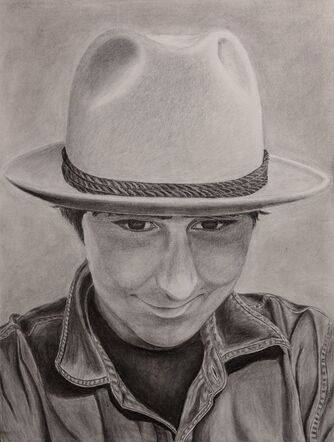Everything in my field of view makes a sound. These sounds are constant, I cannot turn them off, and they are always consistent. These synesthetic sounds are not random: they follow a set of rules. Movement is always the loudest thing in my field of view, followed by what I’m looking at directly, with everything in my peripheral vision a layered hum under that. Smaller things are higher pitched than larger ones, and faster-moving objects are higher pitched than slower ones. I hear moving objects as sliding notes that rise and fall with their course. For example, if I see a songbird fly by, swooping through the sky, I hear a pitch that bends up and down with the bird's path, and its quick wing flaps sound like the high-pitched ticks of rapping fingernails on glass. Unlike western music, the sounds I hear are not restricted to the 12-note scale. Instead, they slide up and down smoothly, often landing between notes.
In addition to hearing movement, when I look at a shape I hear a chord. This chord is determined by the number and relative length of its sides. A square makes a single note that is higher or lower based how much of my field of view it occupies. A rectangle, however, makes a two-note chord, with the long side lower pitched and the short side higher. The interval between the two is determined by the difference in length. Organic shapes are much more complex-sounding, with the individual pieces harder to distinguish, but the same general rules apply.
Color does not affect the pitch of a given sound; instead it changes the timbre. For example, if I see two frisbees fly by -- one red, one blue, tracing the same arc through the sky -- they will both make the same pitch, bending up and back down with the course of their flight. However, the red one will sound slightly grating and brassy and the blue will be a much smoother hum. Warm colors -- red yellow, and particularly orange -- sound harsher, buzzier and more piercing. Cool colors -- blue, purple and green -- make a more calming, resonant hum. Green is the quietest and smoothest-sounding color, with orange the loudest and most in your face. The difference is similar to that between a bowed cello and buzzy, screaming trumpet.
I love painting scenes from nature, such as landscapes, trees and flowers, because unlike man-made objects, there is almost nothing in nature that sounds bad to me. This is due to the complex patterns inherent in living things. These patterns create beautiful, intricate harmonies that I try to capture in my work. For example, when I look at a tree I hear a chord defined primarily by its shape. Each tree has its own unique chord; however, two trees of the same species will sound similar because the branches split from the trunk at similar angles and bend and curve in similar ways. This creates repeating patterns and shapes that I hear as a common texture shared by every individual of the species. Poplar, for example, love to grow vertically and their branches are very consistent, nearly always angling steeply up to the sky, rarely spreading far from the trunk. This creates lots of acute angles and relatively straight lines, giving their sound a sharp, stern texture. A contorted filbert is on the other end of the spectrum. Their branches grow in twirly spirals. This creates lots of overlapping, curved shapes and gives them a loose, playful sound. Pattern is everywhere in nature, giving natural objects a complexity of sound I find often lacking in man-made things. I try to reflect this in my paintings by making pattern and rhythm a focus of my work -- often with thick, textural brushstrokes. With consistency of mark making, and repetition of shape, I add intricacy to the harmonies in my work to more closely imitate those I perceive nature.
When I look at a painting I hear a complex, layered wall of sound that encompasses all aspects of the work -- its proportions, curves, shapes and colors all blended together into one complex chord. This overall chord lasts for a few seconds and then fades as my eyes start to roam over the painting lifting individual pieces of the chord to the forefront. I can always return to that overview chord by looking away from a painting and back, or closing my eyes for a moment and opening them again. This overall harmony of a piece guides my work from start to finish. When taking photos, I listen to what I hear through the eyepiece and press the shutter when the relative proportions of what I’m seeing fall into harmony. When sketching, I do the same, framing things in different ways until I find one that sounds best to me. When adding to a work in progress, I listen to the overall chord, add a few more brushstrokes and then go back to the chord to determine the impact they had. In this way I am careful to ensure that each addition to a painting is consistent and that each area within a painting has a similar auditory texture, ensuring they blend together into a coherent whole. It is my hope that through my artwork I am able to capture some of the beautiful harmony I perceive in the world, and translate it for everyone to appreciate.
